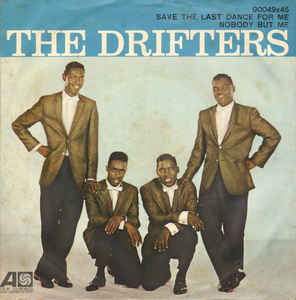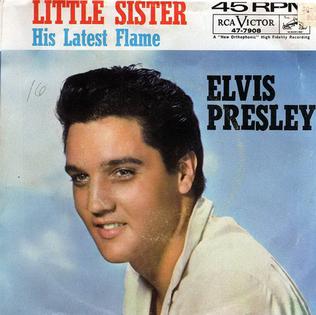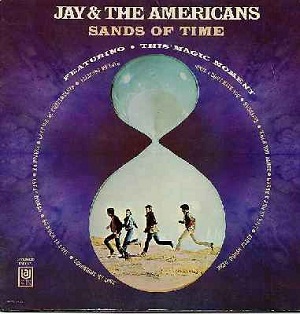Related Research Articles

Doo-wop is a subgenre of rhythm and blues music that originated in African-American communities during the 1940s, mainly in the large cities of the United States, including New York, Philadelphia, Pittsburgh, Chicago, Baltimore, Newark, Detroit, Washington, D.C., and Los Angeles. It features vocal group harmony that carries an engaging melodic line to a simple beat with little or no instrumentation. Lyrics are simple, usually about love, sung by a lead vocal over background vocals, and often featuring, in the bridge, a melodramatically heartfelt recitative addressed to the beloved. Harmonic singing of nonsense syllables is a common characteristic of these songs. Gaining popularity in the 1950s, doo-wop was "artistically and commercially viable" until the early 1960s and continued to influence performers in other genres.
The Belmonts were an American doo-wop group from the Bronx, New York, that originated in the mid-1950s. The original group consisted of Angelo D'Aleo, Carlo Mastrangelo, and Fred Milano. They took their name from Belmont, the Bronx street in which Mastrangelo lived, known as the Little Italy of the Bronx. From 1958–60 the group performed with Dion DiMucci as Dion and the Belmonts. At this time Mastrangelo sang the bass parts, Milano the second tenor, D'Aleo the falsetto, and DiMucci did lead vocals. Mastrangelo was replaced in 1962 by Frank Lyndon and Warren Gradus, but the original group reunited in 1966, and thereafter performed together in numerous reunions over the years. They occasionally recorded new singles into the 1980s and performed live until the death of Milano in 2011. Gradus continued, performing live under the moniker until his death in October 2023.

Jerome Solon Felder, known professionally as Doc Pomus, was an American blues singer and songwriter. He is best known as the co-writer of many rock and roll hits. Pomus was inducted into the Rock and Roll Hall of Fame as a non-performer in 1992, the Songwriters Hall of Fame (1992), and the Blues Hall of Fame (2012).

Dion Francis DiMucci, better known mononymously as Dion, is an American singer and songwriter. His music incorporates elements of doo-wop, pop, rock, R&B, folk and blues. Initially the lead singer of the vocal group Dion and the Belmonts, Dion embarked on a solo career, and was one of the most prominent rock and roll performers of the pre-British Invasion era. He had 39 Top 40 hits in the late 1950s and early 1960s as a solo performer, or with the Belmonts and the Del-Satins. He is best remembered for his signature hit songs "Runaround Sue", "The Wanderer", "Ruby Baby" and "Lovers Who Wander", among others.

Mortimer Shuman was an American singer, pianist and songwriter, best known as co-writer of many 1960s rock and roll hits, including "Viva Las Vegas". He also wrote and sang many songs in French, such as "Le Lac Majeur", "Papa-Tango-Charly", "Sha Mi Sha", "Un Été de Porcelaine", and "Brooklyn by the Sea" which became hits in France and several other European countries.
"Hushabye" is a song that was written by Doc Pomus and Mort Shuman in 1959 for the Brooklyn doo-wop quintet the Mystics. The group's recording of the song was a Top 20 hit.

"Save the Last Dance for Me" is a song written by Doc Pomus and Mort Shuman, first recorded in 1960 by American musical group the Drifters with Ben E. King on lead vocals. It has since been covered by several artists, including Dalida, the DeFranco Family, Emmylou Harris, Dolly Parton, and Michael Bublé.
The Mystics are an American rock and roll group that began in Brooklyn, New York, United States, in the late 1950s. The group was known as The Overons, a quintet that, when signed to Laurie Records, consisted of Phil Cracolici, Albee Cracolici, George Galfo, Bob Ferrante, and Al Contrera. Under the direction of their manager, Jim Gribble, The Overons became The Mystics when each group member wrote a name they liked on a slip of paper and placed the papers in a hat; Contrera's choice was drawn.

Dion and the Belmonts were an American vocal quartet prominent throughout the 1950s. All of its members were from the Bronx, New York City. In 1957, Dion DiMucci joined the vocal group the Belmonts. The established trio of Angelo D'Aleo, Carlo Mastrangelo and Fred Milano formed a quartet with DiMucci.

"Viva Las Vegas" is a 1964 song recorded by Elvis Presley written by Doc Pomus and Mort Shuman for his film of the same name, which along with the song was set for general release the year after. Although Elvis Presley never performed the song live, it has since become popular and often performed by others. The RIAA certified the single disc "Viva Las Vegas/What'd I Say" gold on March 27, 1992, having sold 500,000 copies in the United States.

"Runaround Sue" is a rock and roll song, originally a US No. 1 Hot 100 hit for the singer Dion during 1961, after he split with the Belmonts. It was written by Dion with Ernie Maresca, and tells the story of a disloyal lover. The song ranked No. 351 on the Rolling Stone list of "The 500 Greatest Songs of All Time".

"(Marie's the Name) His Latest Flame" is a song recorded in a hit version by Elvis Presley and published by Elvis Presley Music in 1961. It was written by Doc Pomus and Mort Shuman and first recorded by Del Shannon on the album Runaway with Del Shannon, which was released in June 1961.

"Surrender" is a number 1 song recorded by Elvis Presley and published by Elvis Presley Music in 1961. It is an adaptation by Doc Pomus and Mort Shuman of the music of a 1902 Neapolitan ballad by Giambattista and Ernesto de Curtis entitled "Torna a Surriento". It hit number one in the US and UK in 1961 and eventually became one of his best-selling singles. Presley held the record for most consecutive number one singles on the Billboard Hot 100 before 1966, when The Beatles beat the record, with six consecutive number ones released between 1965 and 1966. That record eventually was broken in 1988 by Whitney Houston, who continues to hold the record today with seven. It would hold the record for most consecutive number ones by a solo artist until Houston broke that record with "So Emotional". This was one of 25 songs which Doc Pomus and Mort Shuman wrote for Presley. It has been recorded by many other artists, including Michael Bublé, The Residents and Il Volo.
"Turn Me Loose" is a song written by Doc Pomus and partner, Mort Shuman, upon the request of the managers of teen idol, Fabian Forte. The song became Fabian's first hit record, reaching number nine in the Billboard Hot 100 chart in 1959.

Sands of Time is the seventh studio album by Jay and the Americans released on March 15, 1969. The album went to #51 on the Billboard 200 chart, reached #30 on the Cashbox chart, and #47 in Canada.
John Leslie McFarland was an American popular music composer and arranger.

For Teenagers Only is an album by American singer Bobby Darin, released in 1960. After Darin's success in the adult pop market, the release of the album was an attempt to regain his youthful Rock & Roll audience. Nearly all of the material had been previously recorded in 1958. The album did not chart on the Billboard 200, but reached #38 on the Cashbox mono chart.
This is the discography for American musician Dion DiMucci.
"Go, Jimmy, Go" is a song written by Doc Pomus and Mort Shuman and performed by Jimmy Clanton. It reached #5 on the U.S. pop chart on July 12, 1959, and #19 on the U.S. R&B chart. It was featured on Clanton's 1961 album My Best to You. The song ranked #33 on Billboard magazine's Top 100 singles of 1960.

Rock & Roll Is Here to Stay! is the debut album by American doo-wop and rock & roll group Sha Na Na, issued in 1969 and reissued in 1973.
References
- ↑ "Presenting Dion & The Belmonts - Dion & the Belmonts | Songs, Reviews, Credits". AllMusic . Retrieved April 4, 2022.
- 1 2 "Dion Chart History (Hot 100)". Billboard.
- ↑ "Biography of Doc Pomus". Archived from the original on April 15, 2008. Retrieved March 26, 2008.
- 1 2 Vickers, Graham (2013). Pomus & Shuman: Hitmakers Together & Apart. Omnibus. ISBN 9780857128003.
- ↑ Reynolds, Robert (2017). Vanilla Doo-Wop. p. 80. ISBN 9781365804601.
- ↑ "Distributor News". Billboard. April 6, 1959. p. 6.
- ↑ "Billboard Hot 100". Billboard. May 18, 1959. p. 41.
- ↑ "A Teenager in Love - Dion & the Belmonts | Songs, Reviews, Credits". AllMusic . Retrieved April 4, 2022.
- "The Best of Dion and the Belmonts [1994] - Dion & the Belmonts | Songs, Reviews, Credits". AllMusic . Retrieved April 4, 2022.
- "The Very Best of Dion & The Belmonts by Dion & The Belmonts". January 1, 2005. Retrieved April 4, 2022– via Apple Music.
- "The Best of Dion and the Belmonts [2001] - Dion & the Belmonts | Songs, Reviews, Credits". AllMusic . Retrieved April 4, 2022.
- "Their Best - Dion & the Belmonts | Songs, Reviews, Credits". AllMusic . Retrieved April 4, 2022.
- "The Best of Dion & The Belmonts [2005] - Dion, Dion & the Belmonts | Songs, Reviews, Credits". AllMusic . Retrieved April 4, 2022.
- "24 Golden Greats - Dion & the Belmonts | Songs, Reviews, Credits". AllMusic . Retrieved April 4, 2022.
- ↑ "CHUM Hit Parade, week of May 25, 1959".
- ↑ "dion & The Belmonts: Artist Chart History". Official Charts Company.
- ↑ Pareles, Jon (October 9, 2004). "At a Reunion With the Fugs, Teenage Days Have Moved On". The New York Times . Retrieved April 4, 2022.